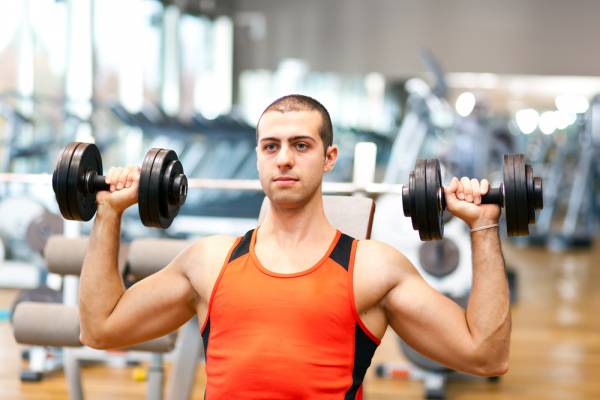Similar exercises using different modes or implements can result in varied muscle activation, joint stability, and the inability to compare one-repetition maximum (1RM) efforts between modes. That is pretty much undisputable. We also know that if you work as hard as you can against whatever resistance is used – whether it’s a free weight or machine – you will accrue positive results.
Similar exercises using different modes or implements can result in varied muscle activation, joint stability, and the inability to compare one-repetition maximum (1RM) efforts between modes. That is pretty much undisputable. We also know that if you work as hard as you can against whatever resistance is used – whether it’s a free weight or machine – you will accrue positive results.
But if there is an acknowledged difference between using a barbell and a dumbbell, what is the difference? And shouldn’t you know this to properly plan your training for your desired outcome? In this case, we’re going to discuss a barbell against dumbbells relative to the overhead press exercise, and whether you are seated or standing.
A Norwegian study compared a seated and standing barbell overhead press with a seated and standing dumbbell overhead press. The extent of muscle activation via electromyographic activity (EMG) and strength via a 1RM were the aim. The researchers hypothesized the greater the stability required (dumbbells more than a barbell and standing more than seated) would show equal EMG activity of the various shoulder muscles, but a lesser 1RM. EMG testing was done at the anterior, medial, and posterior deltoids, as well as the biceps and triceps brachii.
The participants in the study were fifteen healthy men (age, 22 ± two years, average weight 174 ± 30 pounds, and height 5’-10.5” ± 2.5”). They were not competitive power- or Olympic lifters, but they did have an average of five years of strength-training experience.
Four testing sessions were used separated by three to five days of rest. Here were the objectives of each session:
- Session #1: Determine a 1RM in the seated barbell and seated dumbbell presses.
- Session #2: Determine a 1RM in the standing barbell and standing dumbbell presses.
- Session #3: With 80% of their 1RM, each participant performed five repetitions on each exercise in randomized order.
- Session #4: Done with the experimental group, and identical to the third session, but added EMG measurements.
Notes: A four-minute rest was given between each 1RM attempt in sessions one and two. The seated presses used an upright bench with a 75-degree back support. This can assist with mid-section and core stability and therefore augment ability.

I think you all get the basis of this study. It was practical, simple, and realistic in intent. So, what was determined?
Front shoulder (anterior deltoid) EMG results
- Seated barbell vs. seated dumbbell – muscle activation was 11% greater for the seated dumbbell press.
- Standing barbell vs. standing dumbbell – muscle activation was 15% greater for the standing dumbbell press.
- Seated dumbbell vs. standing dumbbell – muscle activation was 8% greater for the standing dumbbell press.
Middle shoulder (medial deltoid) EMG results
- Standing barbell vs. standing dumbbell – muscle activation was 7% greater for the standing dumbbell press.
- Seated dumbbell vs. standing barbell – muscle activation was 7% greater for the standing barbell press.
Back shoulder (posterior deltoid) EMG results
- Seated barbell vs. standing barbell – muscle activation was 25% greater for the standing barbell press.
- Seated dumbbell vs. standing dumbbell – muscle activation was 24% greater for the standing dumbbell press.
Biceps brachii EMG results
- Seated barbell vs. seated dumbbell – muscle activation was 33% greater for the seated barbell press.
- Standing barbell vs. standing dumbbell – muscle activation was 16% greater for the standing barbell press.
- Seated dumbbell vs. standing dumbbell – muscle activation was 23% greater for the standing dumbbell press.
Triceps brachii EMG results
- Standing barbell vs. standing dumbbell – muscle activation was 39% greater for the standing barbell press.
- Seated barbell vs. standing barbell – muscle activation was 20% greater for the standing barbell press.
When it came to the 1RM strength test, the standing barbell press was 7% greater than the standing dumbbell press and 10% greater than the seated dumbbell press. So, what can be gleaned from this study is pretty simple:
- An overhead press performed standing versus seated requires more stability.
- An overhead press performed standing versus seated results in a lower 1RM.
- The majority of overhead pressing exercises requiring the greatest stability (standing and/or with dumbbells) demonstrated greater neuromuscular activity in the deltoid muscles as compared to exercises performed seated and/or with a barbell.
- The standing barbell press activates the biceps and triceps brachii to a greater extent than the seated barbell press and either the seated or standing dumbbell press.
References:
1. Saeterbakken, A.H. and M.S. Fimland, “Effects of Body Position and Loading Modality on Muscle Activity and Strength in Shoulder Presses,” Journal of Strength and Conditioning Research,” 27 (7): 1824–1831, 2013
Photos courtesy of Shutterstock.






